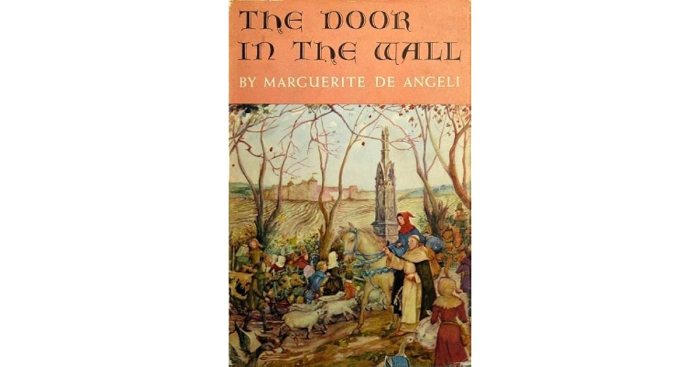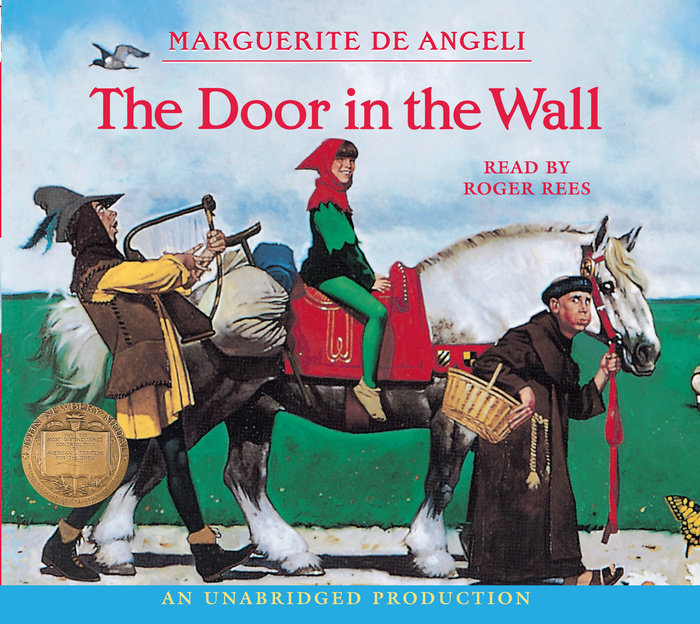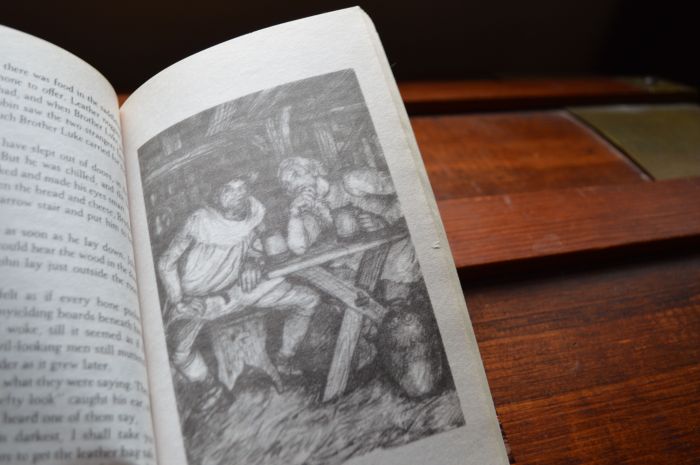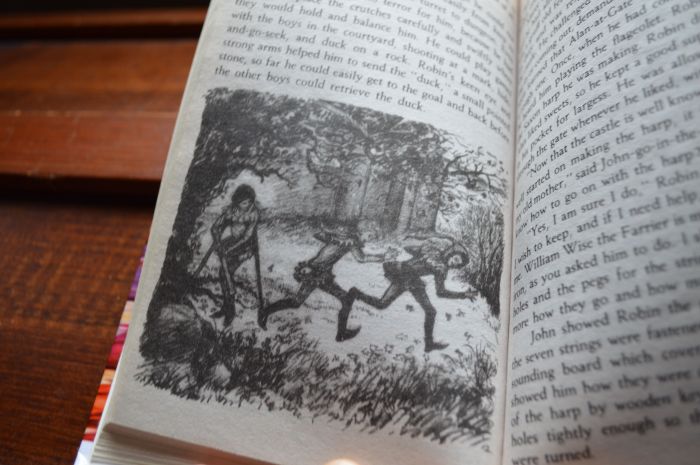Embark on a captivating literary adventure with “Door in the Wall de Angeli,” a story that seamlessly blends historical fiction with the boundless power of imagination, transporting readers to a realm where the ordinary intertwines with the extraordinary.
In the heart of medieval England, a young boy named Robin stumbles upon a mysterious door hidden within the ancient city walls, setting in motion a series of events that will forever alter his life and the course of history.
Door in the Wall de Angeli Book Overview

Door in the Wall is a historical novel by Marguerite de Angeli, first published in 1949. The story is set in medieval England during the 13th century and follows the adventures of Robin, a young boy who runs away from home to join a group of traveling players.
Along the way, Robin encounters a variety of characters, including a friendly friar, a cunning minstrel, and a beautiful lady who helps him find his way. Robin also learns about the harsh realities of medieval life, including the dangers of war and the prejudice against people with disabilities.
Main Characters and Their Roles
- Robin: A young boy who runs away from home to join a group of traveling players.
- Friar Tuck: A friendly friar who helps Robin on his journey.
- Minstrel Alan: A cunning minstrel who tries to take advantage of Robin.
- Lady Marian: A beautiful lady who helps Robin find his way.
Door in the Wall Historical Context

Set in 13th-century England during the reign of King John, Door in the Wallcaptures the tumultuous historical period known as the Middle Ages. This era was characterized by feudalism, religious fervor, and widespread poverty.
The historical context heavily influences the plot and characters. The feudal system, with its rigid social hierarchy, shapes the relationships between the characters. The Church’s power and influence play a significant role in the story, as does the widespread poverty and disease that plagued medieval society.
Incorporation of Historical Events
The author, Marguerite de Angeli, incorporates historical events into the narrative to provide a rich and authentic setting. These events include:
- The Magna Carta: Signed in 1215, this document limited the power of the king and established the rule of law. The story mentions the Magna Carta as a symbol of hope for the oppressed.
- The Crusades: The Crusades were religious wars fought between Christians and Muslims for control of the Holy Land. The story includes a character who is a veteran of the Crusades, bringing firsthand accounts of the horrors of war.
- The Great Famine: A severe famine struck England in 1258, causing widespread hunger and death. The story depicts the devastating effects of the famine on the characters.
Door in the Wall Symbolism

The door in the wall is a powerful symbol in de Angeli’s novel. It represents the gateway between the familiar and the unknown, the past and the present, and the real and the imagined.
Gateway between Worlds
The door in the wall is a physical manifestation of the boundary between the two worlds that exist in the novel. On one side of the door is the familiar world of the medieval village, with its cobblestone streets and thatched-roof cottages.
On the other side is the unknown world of the forest, with its dark trees and hidden dangers.The door represents the choice that the characters must make between the safety of the known and the adventure of the unknown. For Robin, the door is a symbol of hope and escape.
The door in the wall by De Angeli is a classic children’s book that tells the story of a young girl who finds a door in the wall of her house that leads to a magical world. The book has been praised for its beautiful illustrations and its heartwarming story.
For those interested in finding more information about medical providers in the area, the npi number area code 858 can provide valuable insights. Returning to the enchanting world of “The Door in the Wall,” readers can continue to immerse themselves in the timeless tale of wonder and adventure.
He dreams of passing through the door and finding a new life beyond the village. For other characters, such as the villagers, the door is a symbol of fear and danger. They are afraid of what lies beyond the door and they want to keep it closed.The
door is also a symbol of the passage of time. As the novel progresses, the door slowly opens, revealing more and more of the forest. This represents the passage of time and the changing nature of the world. The door is a reminder that the world is always changing and that we must be prepared to adapt to new challenges.
Door in the Wall Character Analysis

The characters in Door in the Wall are complex and well-developed, each playing a significant role in the story’s development. Their motivations, conflicts, and growth contribute to the plot’s richness and depth.
Robin Loxley
- Robin is the protagonist of the story, a young boy who is unjustly accused of stealing a pig.
- His motivation is to clear his name and return to his family.
- His conflict stems from the social injustice he faces and the prejudice against him.
- Throughout the story, Robin grows in courage, determination, and self-reliance.
Brother Mark
- Brother Mark is a monk who helps Robin escape from prison.
- His motivation is to protect the innocent and fight for justice.
- His conflict arises from his struggle to balance his religious beliefs with his desire to help Robin.
- Brother Mark represents the values of compassion, kindness, and forgiveness.
Alan-a-Dale
- Alan-a-Dale is a minstrel who joins Robin on his journey.
- His motivation is to use his music to spread Robin’s story and inspire others.
- His conflict lies in his struggle to find his place in the world.
- Alan-a-Dale represents the power of storytelling and the importance of spreading knowledge.
Maid Marian
- Maid Marian is a young woman who helps Robin and his companions escape from the Sheriff of Nottingham.
- Her motivation is to fight for what is right and protect the people she loves.
- Her conflict stems from the societal expectations placed on her as a woman.
- Maid Marian represents the strength and resilience of women.
The Sheriff of Nottingham
- The Sheriff of Nottingham is the antagonist of the story, a cruel and unjust ruler.
- His motivation is to maintain his power and control over the people of Nottingham.
- His conflict arises from his own greed and selfishness.
- The Sheriff of Nottingham represents the dangers of tyranny and the importance of resisting oppression.
The characters in Door in the Wall interact with each other in complex and meaningful ways. They support, challenge, and inspire each other, contributing to the story’s dynamic plot and rich character development.
Door in the Wall Literary Devices
Margaret de Angeli employs a rich array of literary devices in “Door in the Wall” to enhance the storytelling and convey deeper meanings. These devices contribute to the vivid imagery, symbolism, and emotional impact of the novel.
Foreshadowing
De Angeli uses foreshadowing to hint at future events and create suspense. For instance, the opening scene depicts Robin and his mother’s anxious departure from London, suggesting the challenges and dangers that lie ahead.
Symbolism
The door in the wall serves as a powerful symbol throughout the novel. It represents both the physical and emotional barriers that Robin must overcome, as well as the hope and opportunity that lies beyond them.
Imagery
De Angeli’s vivid imagery immerses the reader in the medieval setting and brings the characters and their experiences to life. Descriptions of the bustling streets of London, the desolate countryside, and the eerie castle evoke a sense of time and place.
Author’s Writing Style
De Angeli’s writing style is characterized by its simplicity and clarity. She uses straightforward language that allows the story to flow smoothly and engages readers of all ages.
Door in the Wall Themes

At the heart of Marguerite de Angeli’s “Door in the Wall,” a tapestry of themes intertwines, exploring universal truths and resonating with readers of all ages. These themes, deeply embedded in the plot, characters, and setting, provide a profound commentary on human experiences and the enduring power of imagination.
Friendship and Loyalty
Friendship and loyalty serve as cornerstones of the narrative. The bond between Robin and Jonathan, forged in the face of adversity, epitomizes unwavering companionship. Their shared adventures, trials, and triumphs showcase the transformative power of friendship in shaping their lives.
Furthermore, the loyalty exhibited by the townspeople towards Robin’s family highlights the importance of community and the strength derived from collective support.
The Power of Imagination, Door in the wall de angeli
Imagination plays a pivotal role in the story, serving as a refuge from the harsh realities of medieval England. Robin’s vivid imagination transforms the ordinary into the extraordinary, creating a world where magic and wonder coexist with everyday life. The “door in the wall,” a symbol of limitless possibilities, invites readers to embrace the power of imagination and the boundless realms it can unlock.
Relevance to Historical Context
The themes explored in “Door in the Wall” resonate deeply with the historical context of 13th-century England. The challenges faced by Robin’s family mirror the hardships endured by countless individuals during a period marked by political turmoil and social inequality.
The story serves as a poignant reminder of the resilience and hope that can prevail even in the face of adversity.
Relevance to Reader’s Experiences
The themes of friendship, loyalty, and imagination transcend time and culture, making “Door in the Wall” a timeless tale that speaks to readers of all ages. The story invites readers to reflect on the importance of these values in their own lives, encouraging them to nurture meaningful connections, cultivate their imaginations, and find solace and inspiration in the world around them.
Q&A: Door In The Wall De Angeli
What is the significance of the door in the wall?
The door represents a gateway between the ordinary world and a realm of boundless imagination and possibility.
How does the historical context influence the story?
The medieval setting provides a backdrop of social and political upheaval, shaping the characters’ motivations and conflicts.
What is the main theme of the story?
The story explores the power of imagination, the importance of friendship, and the enduring impact of historical events.